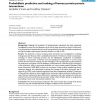Free Online Productivity Tools
i2Speak
i2Symbol
i2OCR
iTex2Img
iWeb2Print
iWeb2Shot
i2Type
iPdf2Split
iPdf2Merge
i2Bopomofo
i2Arabic
i2Style
i2Image
i2PDF
iLatex2Rtf
Sci2ools
BMCBI
2007
2007
Probabilistic prediction and ranking of human protein-protein interactions
Background: Although the prediction of protein-protein interactions has been extensively investigated for yeast, few such datasets exist for the far larger proteome in human. Furthermore, it has recently been estimated that the overall average false positive rate of available computational and high-throughput experimental interaction datasets is as high as 90%. Results: The prediction of human protein-protein interactions was investigated by combining orthogonal protein features within a probabilistic framework. The features include co-expression, orthology to known interacting proteins and the full-Bayesian combination of subcellular localization, co-occurrence of domains and post-translational modifications. A novel scoring function for local network topology was also investigated. This topology feature greatly enhanced the predictions and together with the full-Bayes combined features, made the largest contribution to the predictions. Using a conservative threshold, our most accura...
| Added | 08 Dec 2010 |
| Updated | 08 Dec 2010 |
| Type | Journal |
| Year | 2007 |
| Where | BMCBI |
| Authors | Michelle S. Scott, Geoffrey J. Barton |
Comments (0)

